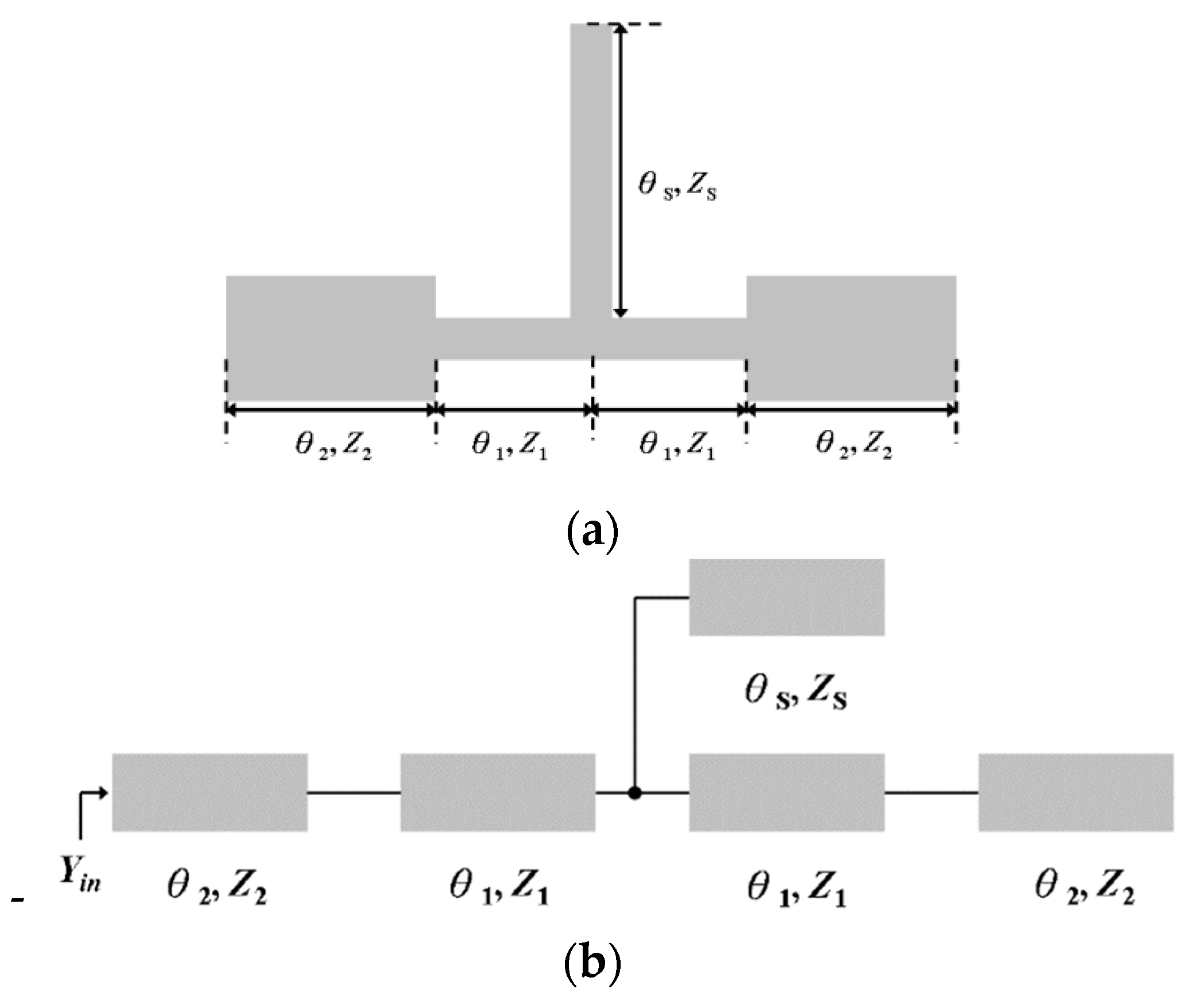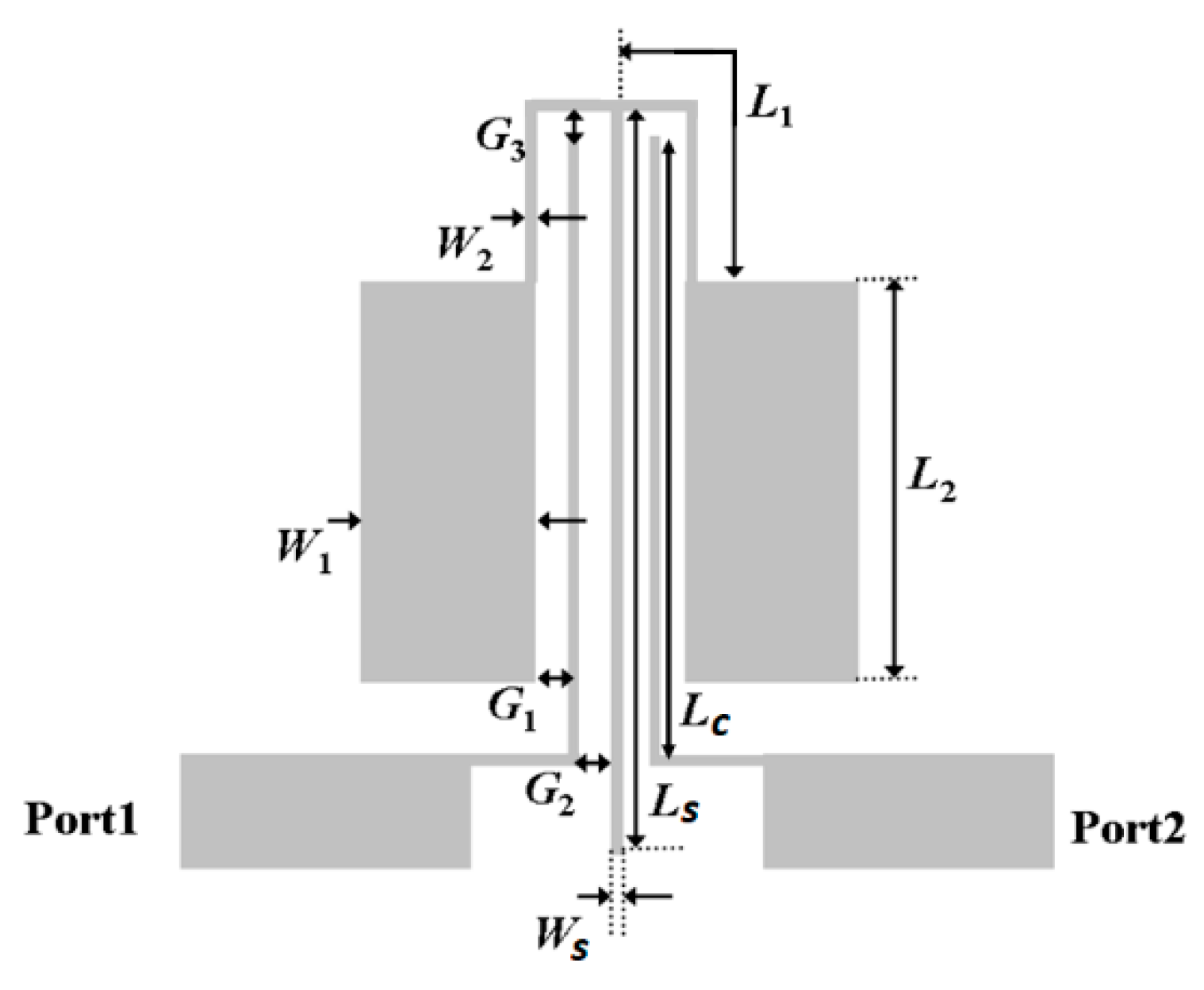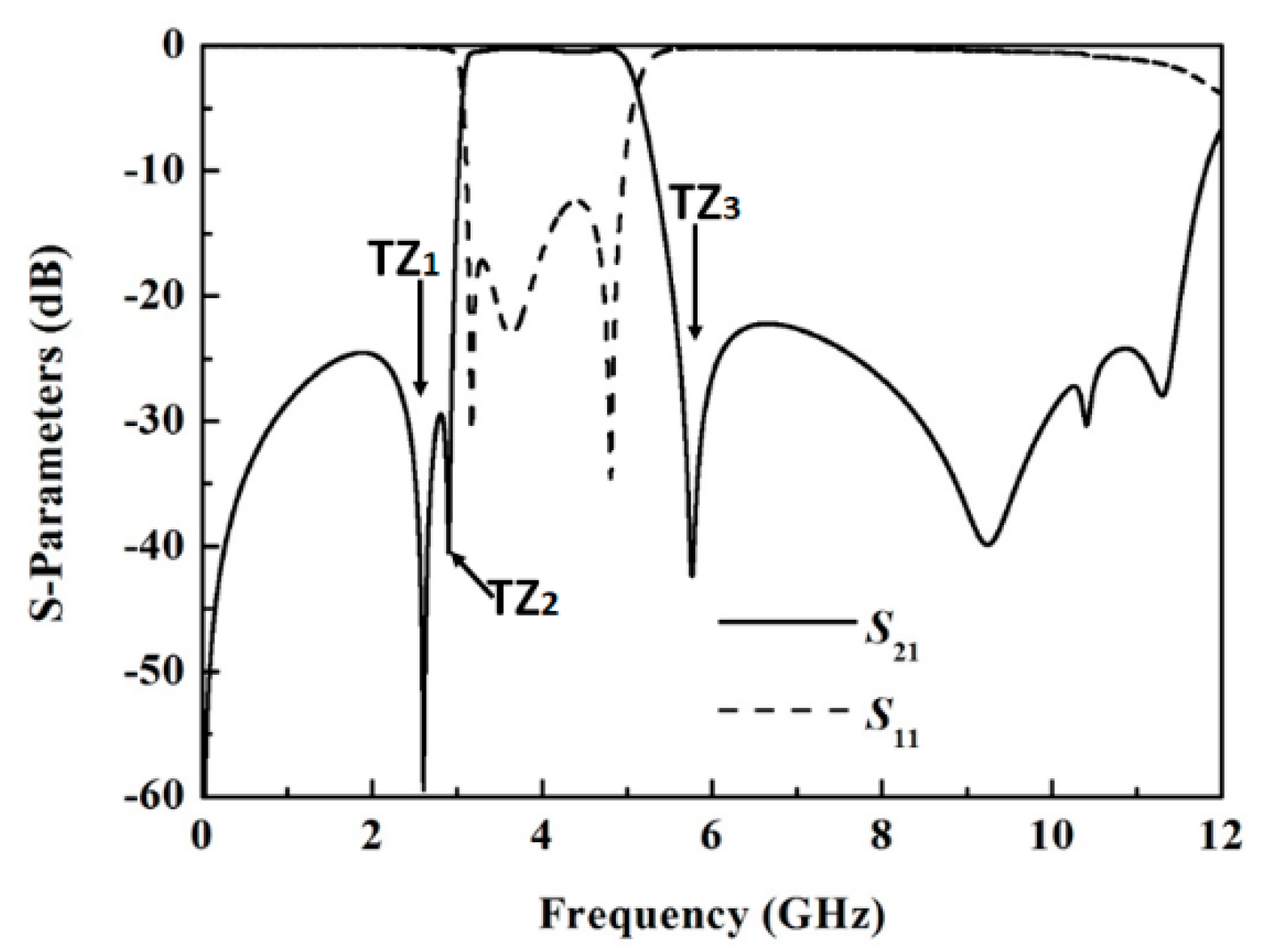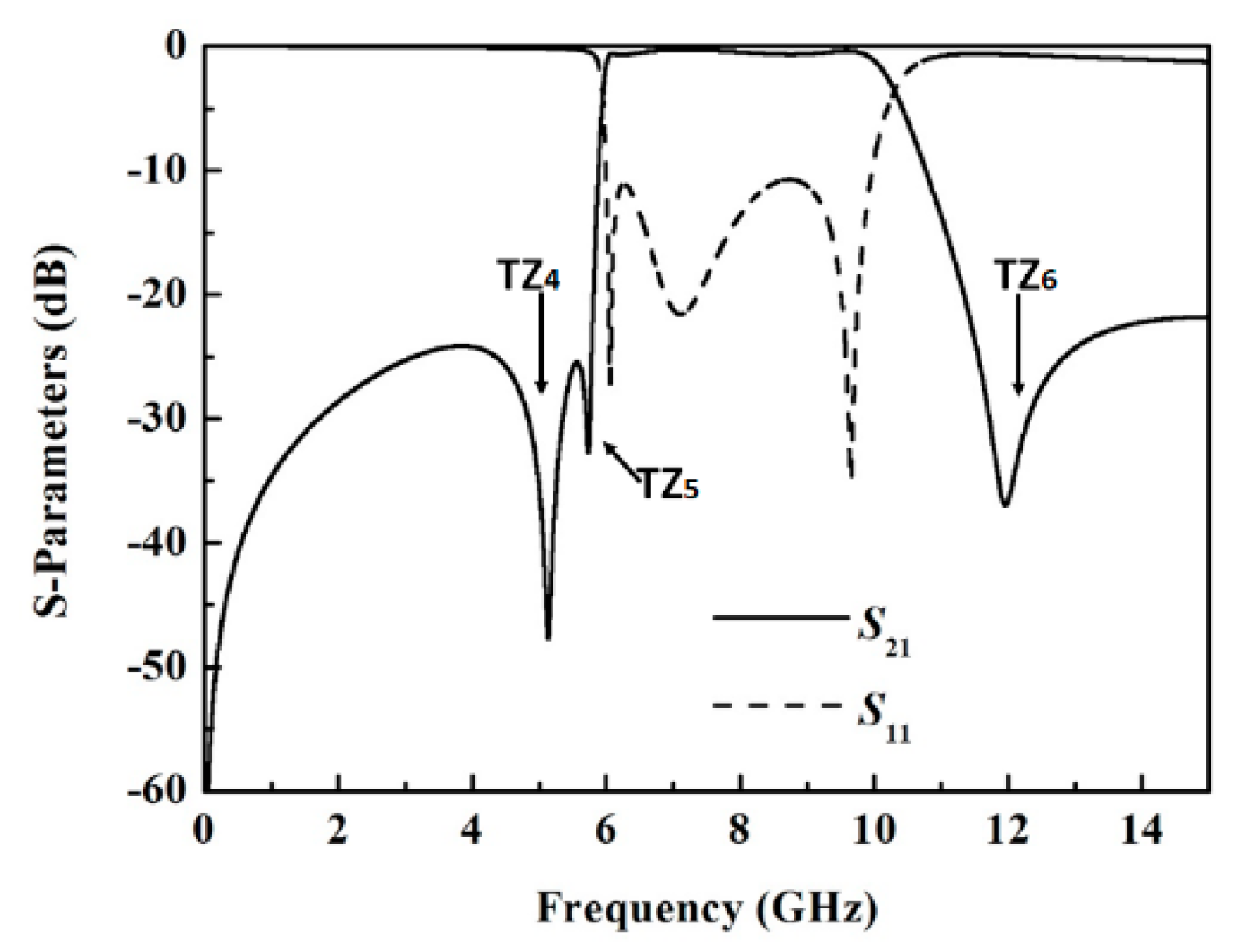Compact Ultra-Wideband Bandpass Filters Achieved by Using a Stub-Loaded Stepped Impedance Resonator
Abstract
:1. Introduction
2. Analysis of the SLSIR
3. UWB BPF with Wide Stopband
3.1. Design Procedure
3.2. Measured Results
4. Design of Dual UWB Bandpass Filter
4.1. Design Procedure
4.2. Measured Results
5. Conclusions
Author Contributions
Funding
Conflicts of Interest
References
- US Federal Communications Commission. Revision of Part 15 of the Commission’s Rules Regarding Ultra-Wideband Transmission Systems. In First Report and Order, ET Docket; Federal Communications Commission: Washington, DC, USA, 2002. [Google Scholar]
- Weng, M.H.; Liu, S.K.; Liu, Y.T.; Hung, C.Y. A low loss ring UWB bandpass filter. Microw. Opt. Tech. Lett. 2008, 50, 2317–2319. [Google Scholar] [CrossRef]
- Kim, C.H.; Chang, K. Ultra-wideband (UWB) ring resonator bandpass flter with a noched band. IEEE Microw. Wirel. Compon. Lett. 2011, 21, 206–208. [Google Scholar] [CrossRef]
- Lan, S.W.; Weng, M.H.; Hung, C.Y.; Chang, S.J. Design of a compact ultra-wideband bandpass filter with an extremely broad stopband region. IEEE Microw. Wireless Compon. Lett. 2016, 26, 392–394. [Google Scholar] [CrossRef]
- Wang, H.; Kang, W.; Miao, C.; Wu, W. Cross-shaped UWB bandpass filter with sharp skirt and notched band. Electron. Lett. 2012, 48, 96–97. [Google Scholar] [CrossRef]
- Lee, J.K.; Kim, Y.S. Ultra-wideband bandpass filter with improved upper stopband performance using defected ground structure. IEEE Microw. Wirel. Compon. Lett. 2010, 20, 316–318. [Google Scholar] [CrossRef]
- Song, Y.; Yang, G.M.; Geyi, W. Compact UWB bandpass filter with dual notched bands using defected ground structures. IEEE Microw. Wirel. Compon. Lett. 2014, 24, 230–232. [Google Scholar] [CrossRef]
- Weng, M.H.; Huang, C.Y.; Hung, C.Y.; Lan, S.W. Design of an ultra-wideband bandpass filter by using coupled three line microstrip structure. J. Electromagn. Waves Appl. 2012, 26, 716–728. [Google Scholar] [CrossRef]
- Weng, M.H.; Hsu, C.W.; Lan, S.W.; Yang, R.Y. An ultra-wideband Bbndpass filter with a notch band and a wide upper bandstop performances. Electronics 2019, 8, 1316. [Google Scholar] [CrossRef] [Green Version]
- Bojra, A.L.; Belenguer, A.; Cascon, J.; Esteban, H.; Boria, V.E. Wideband passband transmission line based on metamaterial-inspired CPW balanced cells. IEEE Antenna Wirel. Propag. Lett. 2011, 10, 1421–1424. [Google Scholar]
- Hameed, M.; Xiao, G.; Najam, A.I.; Qiu, L.; Hameed, T. Quadruple-mode wideband bandpass filter with improved out-of-band rejection. Electronics 2019, 8, 300. [Google Scholar] [CrossRef] [Green Version]
- Chang, Y.C.; Kao, C.H.; Weng, M.H.; Yang, R.Y. Design of compact wideband bandpass filter using asymmetric SIR with low loss, high selectivity and wide stopband. IEEE Microw. Wirel. Compon. Lett. 2008, 18, 770–772. [Google Scholar] [CrossRef]
- Ghatak, R.; Sarkar, P.; Mishra, R.K.; Poddar, D.R. A compact UWB bandpass filter with embedded SIR as band notch structure. IEEE Microw. Wirel. Compon. Lett. 2011, 21, 261–263. [Google Scholar] [CrossRef]
- Li, R.; Zhu, L. Compact UWB bandpass filter using stub-loaded multiple-mode resonator. IEEE Microw. Wirel. Compon. Lett. 2007, 17, 40–42. [Google Scholar] [CrossRef]
- Weng, M.H.; Liauh, C.T.; Wu, H.W.; Vargas, S.R. An ultra-wideband bandpass filter with an embedded open-circuited stub structure to improve in-band performance. IEEE Microw. Wirel. Compon. Lett. 2009, 19, 146–148. [Google Scholar] [CrossRef]
- Zhou, Y.; Yao, B.; Cao, C.; Deng, H.; He, X. Compact UWB bandpass filter using ring open stub loaded multiple-mode resonator. Electron. Lett. 2009, 45, 554–556. [Google Scholar] [CrossRef]
- Chu, Q.X.; Tian, X.K. Design of UWB bandpass filter using stepped-impedance stub-loaded resonator. IEEE Microw. Wirel. Compon. Lett. 2010, 20, 501–503. [Google Scholar] [CrossRef]
- Han, L.; Wu, K.; Zhang, X. Development of packaged ultrawideband bandpass filters. IEEE Trans. Microw. Theory Tech. 2010, 58, 20–228. [Google Scholar]
- Nosrati, M.; Mirzaee, M. Compact wideband microstrip bandpass filter using quasi-spiral loaded multiple-mode resonator. IEEE Microw. Wirel. Compon. Lett. 2010, 20, 607–609. [Google Scholar] [CrossRef]
- Tu, W.H. Sharp-rejection broadband microstrip bandpass filter using penta-mode resonator. Electron. Lett. 2010, 46, 772–773. [Google Scholar] [CrossRef]
- Fan, J.; Zhan, D.; Jin, C.; Luo, J. Wideband microstrip bandpass filter based on quadruple mode ring resonator. IEEE Microw. Wirel. Compon. Lett. 2012, 22, 348–350. [Google Scholar] [CrossRef]
- Kumar, S.; Gupta, R.D.; Parihar, M.S. Multiple band notched filter using C-shaped and E-shaped resonator for UWB applications. IEEE Microw. Wirel. Compon. Lett. 2016, 26, 340–342. [Google Scholar] [CrossRef]
- Zhang, T.; Xiao, F.; Bao, J.; Tang, X.H. Compact ultra-wideband bandpass filter with good selectivity. Electron. Lett. 2016, 52, 210–212. [Google Scholar] [CrossRef]
- Li, Y.; Choi, W.W.; Tam, K.W.; Zhu, L. Novel wideband bandpass filter with dual notched bands using stub-loaded resonators. IEEE Microw. Wirel. Compon. Lett. 2017, 27, 25–27. [Google Scholar]
- Velázquez-Ahumada, M.D.C.; Martel-Villagr, J.; Medina, F.; Mesa, F. Application of stub loaded folded stepped impedance resonators to dual band filters. Prog. Electromagn. Res. 2010, 102, 107–124. [Google Scholar] [CrossRef] [Green Version]
- Liu, S.K.; Zheng, F.-Z. A new compact tri-band bandpass filter using step impedance resonators with open stubs. J. Electromagn. Waves Appl. 2012, 26, 130–139. [Google Scholar] [CrossRef]
- Makimoto, M.; Yamashita, S. Bandpass filter using parallel-coupling stripline stepped impedance resonators. IEEE Trans. Microw. Theory Tech. 1980, 28, 1413–1417. [Google Scholar] [CrossRef]
- Pozar, D.M. Microwave Engineering, 2nd ed.; John Wiley & Sons, Inc.: Hoboken, NJ, USA, 1998. [Google Scholar]
- Hong, J.S.; Lancaster, M.J. Microstrip Filters for RF/Microwave Applications; John Wiley & Sons, Inc.: Hoboken, NJ, USA, 2001. [Google Scholar]
- Zeland Software, Inc. IE3D Simulator; Zeland Software, Inc.: Fremont, CA, USA, 2002. [Google Scholar]









| Ref. [8] | Ref. [9] | Ref. [12] | Ref. [15] | Ref. [23] | Ref. [24] | This Work 1 | This Work 2 | |
|---|---|---|---|---|---|---|---|---|
| Center frequency (GHz) | 3.97 | 4/ 8 | 4 | 6.5 | 1 | 2.3 | 4.2 | 4.05/ 8.05 |
| |S11| (dB) | 15 | 10/12 | 15 | 17 | 15 | 13 | 16.5 | 8/12 |
| |S21| (dB) | 0.8 | 1.3/2.4 | 0.5 | 0.5 | 1.0 | 0.35 | 0.94 | 1.3/1.1 |
| 3-dB FBW (%) | 45.3 | 42/58 | 62.5 | 113 | 123 | 80 | 52.7 | 52/55 |
| Circuit size (λg × λg) | 0.66 × 0.43 | 0.70 × 0.28 | 1.12 × 0.1 | 0.4 × 0.06 | 0.17 × 0.14 | 0.53 × 0.43 | 0.15 × 0.25 | 0.15 × 0.4 |
| Number of notched bands | 0 | 1 | 0 | 1 | 0 | 2 | 0 | 1 |
| Numbers of transmission zeros | 2 | 2 | 3 | 0 | 1 | 1 | 3 | 5 |
© 2020 by the authors. Licensee MDPI, Basel, Switzerland. This article is an open access article distributed under the terms and conditions of the Creative Commons Attribution (CC BY) license (http://creativecommons.org/licenses/by/4.0/).
Share and Cite
Weng, M.-H.; Zheng, F.-Z.; Lai, H.-Z.; Liu, S.-K. Compact Ultra-Wideband Bandpass Filters Achieved by Using a Stub-Loaded Stepped Impedance Resonator. Electronics 2020, 9, 209. https://doi.org/10.3390/electronics9020209
Weng M-H, Zheng F-Z, Lai H-Z, Liu S-K. Compact Ultra-Wideband Bandpass Filters Achieved by Using a Stub-Loaded Stepped Impedance Resonator. Electronics. 2020; 9(2):209. https://doi.org/10.3390/electronics9020209
Chicago/Turabian StyleWeng, Min-Hang, Fu-Zhong Zheng, Hong-Zheng Lai, and Shih-Kun Liu. 2020. "Compact Ultra-Wideband Bandpass Filters Achieved by Using a Stub-Loaded Stepped Impedance Resonator" Electronics 9, no. 2: 209. https://doi.org/10.3390/electronics9020209
APA StyleWeng, M.-H., Zheng, F.-Z., Lai, H.-Z., & Liu, S.-K. (2020). Compact Ultra-Wideband Bandpass Filters Achieved by Using a Stub-Loaded Stepped Impedance Resonator. Electronics, 9(2), 209. https://doi.org/10.3390/electronics9020209





